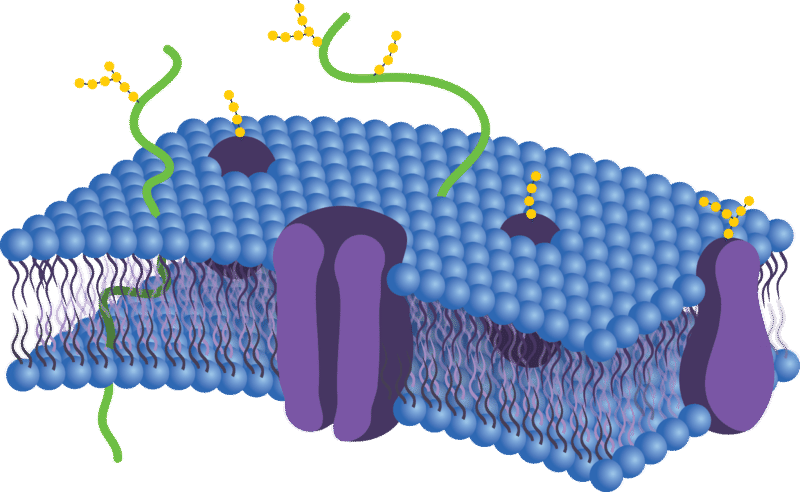2.33: Bicapa fosfolípida
- Page ID
- 108868
\( \newcommand{\vecs}[1]{\overset { \scriptstyle \rightharpoonup} {\mathbf{#1}} } \)
\( \newcommand{\vecd}[1]{\overset{-\!-\!\rightharpoonup}{\vphantom{a}\smash {#1}}} \)
\( \newcommand{\id}{\mathrm{id}}\) \( \newcommand{\Span}{\mathrm{span}}\)
( \newcommand{\kernel}{\mathrm{null}\,}\) \( \newcommand{\range}{\mathrm{range}\,}\)
\( \newcommand{\RealPart}{\mathrm{Re}}\) \( \newcommand{\ImaginaryPart}{\mathrm{Im}}\)
\( \newcommand{\Argument}{\mathrm{Arg}}\) \( \newcommand{\norm}[1]{\| #1 \|}\)
\( \newcommand{\inner}[2]{\langle #1, #2 \rangle}\)
\( \newcommand{\Span}{\mathrm{span}}\)
\( \newcommand{\id}{\mathrm{id}}\)
\( \newcommand{\Span}{\mathrm{span}}\)
\( \newcommand{\kernel}{\mathrm{null}\,}\)
\( \newcommand{\range}{\mathrm{range}\,}\)
\( \newcommand{\RealPart}{\mathrm{Re}}\)
\( \newcommand{\ImaginaryPart}{\mathrm{Im}}\)
\( \newcommand{\Argument}{\mathrm{Arg}}\)
\( \newcommand{\norm}[1]{\| #1 \|}\)
\( \newcommand{\inner}[2]{\langle #1, #2 \rangle}\)
\( \newcommand{\Span}{\mathrm{span}}\) \( \newcommand{\AA}{\unicode[.8,0]{x212B}}\)
\( \newcommand{\vectorA}[1]{\vec{#1}} % arrow\)
\( \newcommand{\vectorAt}[1]{\vec{\text{#1}}} % arrow\)
\( \newcommand{\vectorB}[1]{\overset { \scriptstyle \rightharpoonup} {\mathbf{#1}} } \)
\( \newcommand{\vectorC}[1]{\textbf{#1}} \)
\( \newcommand{\vectorD}[1]{\overrightarrow{#1}} \)
\( \newcommand{\vectorDt}[1]{\overrightarrow{\text{#1}}} \)
\( \newcommand{\vectE}[1]{\overset{-\!-\!\rightharpoonup}{\vphantom{a}\smash{\mathbf {#1}}}} \)
\( \newcommand{\vecs}[1]{\overset { \scriptstyle \rightharpoonup} {\mathbf{#1}} } \)
\( \newcommand{\vecd}[1]{\overset{-\!-\!\rightharpoonup}{\vphantom{a}\smash {#1}}} \)
\(\newcommand{\avec}{\mathbf a}\) \(\newcommand{\bvec}{\mathbf b}\) \(\newcommand{\cvec}{\mathbf c}\) \(\newcommand{\dvec}{\mathbf d}\) \(\newcommand{\dtil}{\widetilde{\mathbf d}}\) \(\newcommand{\evec}{\mathbf e}\) \(\newcommand{\fvec}{\mathbf f}\) \(\newcommand{\nvec}{\mathbf n}\) \(\newcommand{\pvec}{\mathbf p}\) \(\newcommand{\qvec}{\mathbf q}\) \(\newcommand{\svec}{\mathbf s}\) \(\newcommand{\tvec}{\mathbf t}\) \(\newcommand{\uvec}{\mathbf u}\) \(\newcommand{\vvec}{\mathbf v}\) \(\newcommand{\wvec}{\mathbf w}\) \(\newcommand{\xvec}{\mathbf x}\) \(\newcommand{\yvec}{\mathbf y}\) \(\newcommand{\zvec}{\mathbf z}\) \(\newcommand{\rvec}{\mathbf r}\) \(\newcommand{\mvec}{\mathbf m}\) \(\newcommand{\zerovec}{\mathbf 0}\) \(\newcommand{\onevec}{\mathbf 1}\) \(\newcommand{\real}{\mathbb R}\) \(\newcommand{\twovec}[2]{\left[\begin{array}{r}#1 \\ #2 \end{array}\right]}\) \(\newcommand{\ctwovec}[2]{\left[\begin{array}{c}#1 \\ #2 \end{array}\right]}\) \(\newcommand{\threevec}[3]{\left[\begin{array}{r}#1 \\ #2 \\ #3 \end{array}\right]}\) \(\newcommand{\cthreevec}[3]{\left[\begin{array}{c}#1 \\ #2 \\ #3 \end{array}\right]}\) \(\newcommand{\fourvec}[4]{\left[\begin{array}{r}#1 \\ #2 \\ #3 \\ #4 \end{array}\right]}\) \(\newcommand{\cfourvec}[4]{\left[\begin{array}{c}#1 \\ #2 \\ #3 \\ #4 \end{array}\right]}\) \(\newcommand{\fivevec}[5]{\left[\begin{array}{r}#1 \\ #2 \\ #3 \\ #4 \\ #5 \\ \end{array}\right]}\) \(\newcommand{\cfivevec}[5]{\left[\begin{array}{c}#1 \\ #2 \\ #3 \\ #4 \\ #5 \\ \end{array}\right]}\) \(\newcommand{\mattwo}[4]{\left[\begin{array}{rr}#1 \amp #2 \\ #3 \amp #4 \\ \end{array}\right]}\) \(\newcommand{\laspan}[1]{\text{Span}\{#1\}}\) \(\newcommand{\bcal}{\cal B}\) \(\newcommand{\ccal}{\cal C}\) \(\newcommand{\scal}{\cal S}\) \(\newcommand{\wcal}{\cal W}\) \(\newcommand{\ecal}{\cal E}\) \(\newcommand{\coords}[2]{\left\{#1\right\}_{#2}}\) \(\newcommand{\gray}[1]{\color{gray}{#1}}\) \(\newcommand{\lgray}[1]{\color{lightgray}{#1}}\) \(\newcommand{\rank}{\operatorname{rank}}\) \(\newcommand{\row}{\text{Row}}\) \(\newcommand{\col}{\text{Col}}\) \(\renewcommand{\row}{\text{Row}}\) \(\newcommand{\nul}{\text{Nul}}\) \(\newcommand{\var}{\text{Var}}\) \(\newcommand{\corr}{\text{corr}}\) \(\newcommand{\len}[1]{\left|#1\right|}\) \(\newcommand{\bbar}{\overline{\bvec}}\) \(\newcommand{\bhat}{\widehat{\bvec}}\) \(\newcommand{\bperp}{\bvec^\perp}\) \(\newcommand{\xhat}{\widehat{\xvec}}\) \(\newcommand{\vhat}{\widehat{\vvec}}\) \(\newcommand{\uhat}{\widehat{\uvec}}\) \(\newcommand{\what}{\widehat{\wvec}}\) \(\newcommand{\Sighat}{\widehat{\Sigma}}\) \(\newcommand{\lt}{<}\) \(\newcommand{\gt}{>}\) \(\newcommand{\amp}{&}\) \(\definecolor{fillinmathshade}{gray}{0.9}\)
Todas las células tienen una membrana plasmática. Esta membrana rodea la célula. Entonces, ¿cuál es su papel?
¿Pueden las moléculas entrar y salir de la célula? Sí. ¿Puede entrar o salir algo o todo? No. Entonces, ¿qué determina qué puede entrar o salir? ¿Es el núcleo? ¿El ADN? ¿O la membrana plasmática?
La Membrana Plasma
La membrana plasmática (también conocida como membrana celular) forma una barrera entre el citoplasma dentro de la célula y el ambiente fuera de la célula. Protege y soporta la célula y además controla todo lo que entra y sale de la célula. Permite que solo pasen ciertas sustancias, mientras mantiene a otras dentro o fuera. La capacidad de permitir que solo ciertas moléculas entren o salgan de la célula se conoce como permeabilidad selectiva o semipermeabilidad. Para entender cómo la membrana plasmática controla lo que cruza dentro o fuera de la célula, es necesario conocer su composición.
Una bicapa fosfolipídica
La membrana plasmática está compuesta principalmente por fosfolípidos, los cuales consisten en ácidos grasos y alcohol. Los fosfolípidos en la membrana plasmática están dispuestos en dos capas, llamadas bicapa de fosfolípidos. Como se muestra en la Figura a continuación, cada molécula de fosfolípido tiene una cabeza y dos colas. La cabeza “ama” el agua (hidrofílica) y las colas “odian” el agua (hidrofóbica). Las colas que odian el agua están en el interior de la membrana, mientras que las cabezas amantes del agua apuntan hacia afuera, ya sea hacia el citoplasma o el fluido que rodea a la célula.
Las moléculas que son hidrófobas pueden pasar fácilmente a través de la membrana plasmática, si son lo suficientemente pequeñas, porque odian el agua como el interior de la membrana. Las moléculas que son hidrófilas, por otro lado, no pueden pasar a través de la membrana plasmática —al menos no sin ayuda— porque son amantes del agua como el exterior de la membrana, y por lo tanto están excluidas del interior de la membrana.
 Bicapa Fosfolípida. La bicapa de fosfolípidos consiste en dos capas de fosfolípidos, con un interior hidrófobo o que odia el agua y un exterior hidrófilo o amante del agua. El grupo de cabeza hidrofílico (polar) y las colas hidrofóbicas (cadenas de ácidos grasos) se representan en la molécula de fosfolípido individual. El grupo de cabeza polar y las cadenas de ácidos grasos están unidos por una unidad de glicerol de 3 carbonos.
Bicapa Fosfolípida. La bicapa de fosfolípidos consiste en dos capas de fosfolípidos, con un interior hidrófobo o que odia el agua y un exterior hidrófilo o amante del agua. El grupo de cabeza hidrofílico (polar) y las colas hidrofóbicas (cadenas de ácidos grasos) se representan en la molécula de fosfolípido individual. El grupo de cabeza polar y las cadenas de ácidos grasos están unidos por una unidad de glicerol de 3 carbonos. Viernes de Ciencias: Maíz caramelo en el espacio
El maíz dulce es una delicia muy sabrosa. En este video de Science Friday, el astronauta Don Pettit utiliza Candy Corn para demostrar los efectos de las interacciones hidrofóbicas e hidrofílicas.
Resumen
- La membrana plasmática forma una barrera entre el citoplasma y el ambiente fuera de la célula. La membrana plasmática tiene permeabilidad selectiva.
- La membrana plasmática está compuesta principalmente por fosfolípidos dispuestos en una bicapa, con las colas hidrofóbicas en el interior de la membrana, y las cabezas hidrófilas apuntando hacia afuera.
Revisar
- Describir el papel de la membrana plasmática.
- ¿Qué se entiende por semipermeabilidad?
- Describir la composición de la membrana plasmática.
- Explica por qué las moléculas hidrófobas pueden cruzar fácilmente la membrana plasmática, mientras que las moléculas hidrófilas no
| Imagen | Referencia | Atribuciones |
 |
[Figura 1] | Crédito: flickr:stellarr Fuente: http://www.flickr.com/photos/21187899@N03/2058985902/ Licencia: CC BY 2.0 |
 |
[Figura 2] | Crédito: Mariana Ruiz Villarreal (LadyOFHats) para la Fundación CK-12 Fuente: Fundación CK-12 Licencia: CC BY-NC 3.0 |

